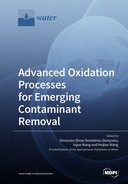Explore

Advanced Oxidation Processes for Emerging Contaminant Removal
0 Ungluers have
Faved this Work
Login to Fave
This Special Issue includes manuscripts on mechanistic understanding, development, and implementation of advanced oxidation processes (AOPs) for the removal of contaminants of emerging concern in water and wastewater treatment. The main goal was successfully achieved under the joint effort of authors, anonymous reviewers, and editorial managers. In total, one review and 15 research papers are included in the Special Issue. These are mainly focused on catalyst synthesis, reactor design, treatment performance, kinetic modeling, reaction mechanisms, and by-product formation during electrochemical, photocatalytic, plasma, persulfate, chlorine, ozone-based, and Fenton-related AOPs at different scales. This Special Issue has received attention from researchers from different parts of the world such as Argentina, Brazil, Canada, China, Germany, India, Mexico, and the USA. The guest editors are happy to see that all papers presented are innovative and meaningful, and hope that this Special Issue can promote mechanistic understanding and engineering applications of AOPs for the removal of contaminants of emerging concern in water.
This book is included in DOAB.
Why read this book? Have your say.
You must be logged in to comment.
Rights Information
Are you the author or publisher of this work? If so, you can claim it as yours by registering as an Unglue.it rights holder.Downloads
This work has been downloaded 69 times via unglue.it ebook links.
- 69 - pdf (CC BY) at Unglue.it.
Keywords
- 14C-labeled PFOA
- acrylic fiber manufacturing wastewater
- adsorption
- advanced oxidation
- advanced oxidation method
- advanced oxidation process
- advanced oxidation processes
- anodic oxidation
- atrazine
- azo dyes
- benzene derivatives
- biodegradability
- bisphenol A mineralization
- boron-doped diamond electrodes
- BPA degradation
- bromide (Br−)
- BTEX
- catalytic ozonation
- CeO2
- chemical oxidation
- chlorine
- combination system
- composite catalyst
- concern
- contaminant
- copper–magnesium oxide/carbon nitride composite
- degradation mechanism
- degradation pathways
- discarded metal waste
- discharge plasma
- disinfection by-products
- electro-hybrid ozonation–coagulation (E-HOC)
- electrochemical
- electrochemical oxidation
- Emerging
- emerging contaminant
- energy per order
- Environmental remediation
- Fenton
- Fenton reaction
- groundwater pollution
- heterogeneous catalyst
- heterogeneous electro-Fenton
- History of engineering & technology
- hydroxyl radical
- immobilized catalyst
- intrinsic kinetics
- kinetic models
- laundry wastewater
- Mechanical engineering & materials
- medium pressure UV/chlorine
- mesoporous
- metal–organic framework
- methyl orange
- micro-pollutant treatment
- Microplastic
- micropollutants
- Monte Carlo
- nanocomposite catalysts
- novel plasma reactor
- oxidation
- oxidized degradation
- ozonation
- packed bed
- per and polyfluorinated alkyl substances
- Performance
- persulfate
- pharmaceuticals
- photo-Fenton
- photocatalysis
- Plasma
- plasma technology
- PMS activation
- radical
- radical contribution rates
- reactive species
- reactor design
- response surface methodology (RSM)
- RhB degradation
- Rhodamine B dye
- solar photo-Fenton
- sol–gel
- surfactant
- Sustainable development goals
- Technology, engineering, agriculture
- Technology: general issues
- textile wastewater
- TiO2 doped
- titanium dioxide
- UV
- UV-LEDs
- UV/chlorine
- UV/PDS
- Water
Links
DOI: 10.3390/books978-3-0365-6610-8Editions

